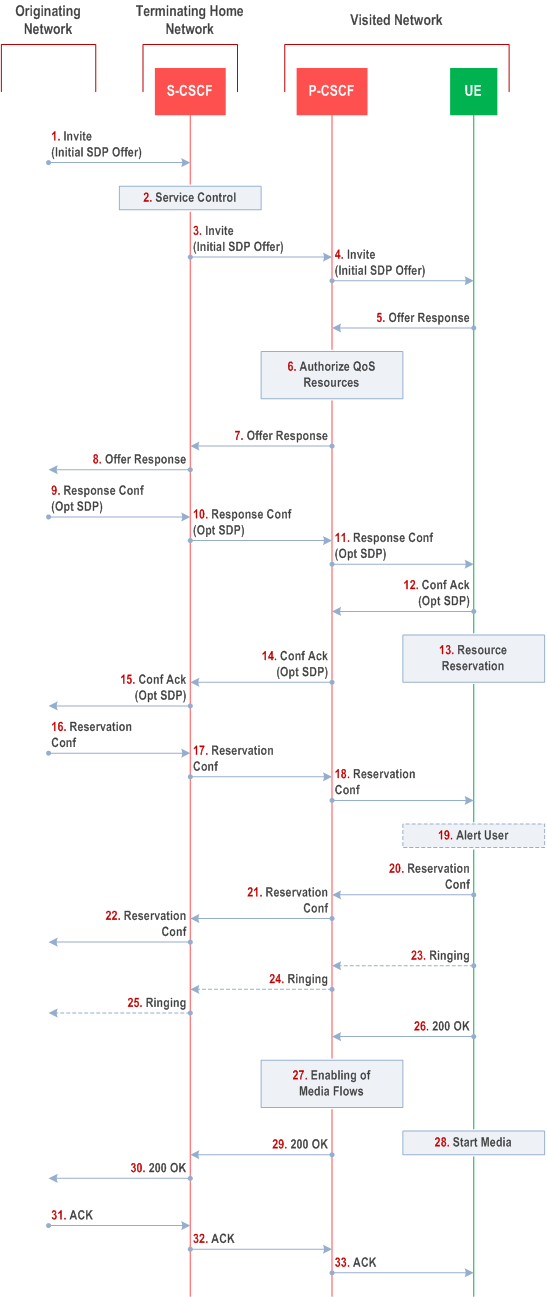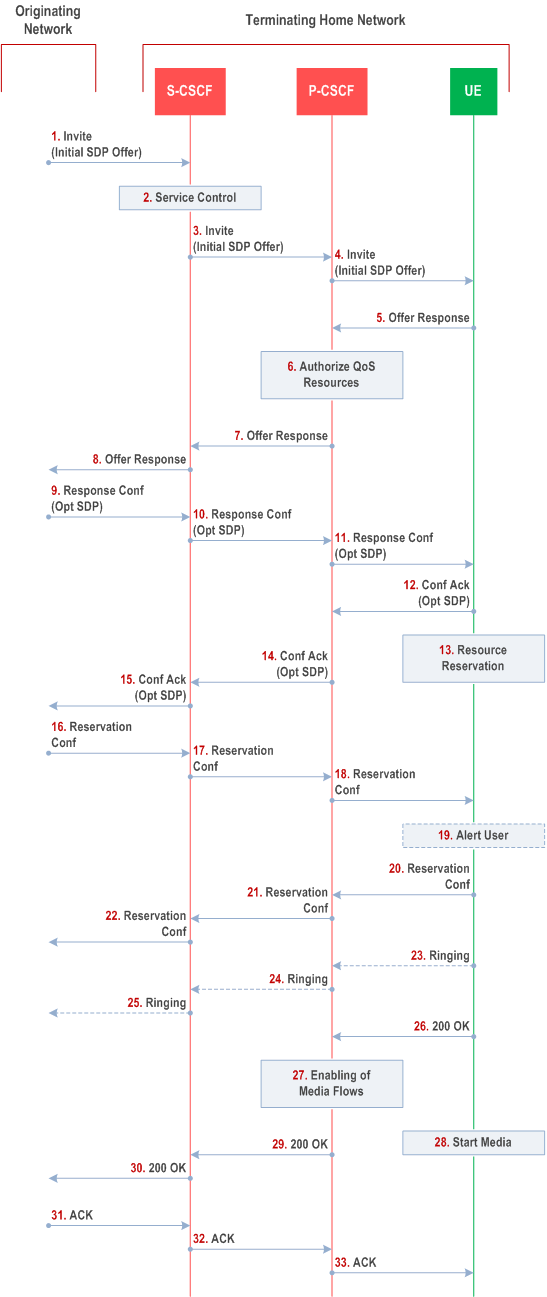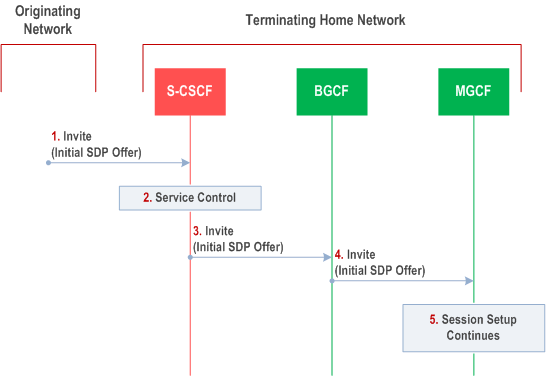Content for TS 23.228 Word version: 18.6.0
1…
3…
4…
4.2.4…
4.3…
4.4…
4.13…
4.16…
5…
5.2…
5.3…
5.4…
5.4.7…
5.4.8…
5.4a…
5.5…
5.5.3…
5.6…
5.6.3…
5.7…
5.7.3…
5.7.5…
5.7.8…
5.8…
5.10…
5.11…
5.11.3…
5.11.3.3
5.11.3.4
5.11.4…
5.11.5…
5.11.5.3…
5.11.6…
5.12…
5.16…
5.16.2…
5.19…
5.20…
A…
E…
E.2.2…
G…
G.5…
H
I…
J…
K…
L…
M…
M.3…
N…
P…
Q…
Q.2.5…
R…
S…
T…
U…
U.2…
V…
W…
X…
Y…
Z…
AA…
AA.3…
AB…
AC…
AC.7…
AC.7.2…
AC.7.2.2
AC.7.2.3…
AC.7.4…
AC.9…
5.7 Termination procedures
5.7.0 General
5.7.1 (MT#1) Mobile termination, roaming
5.7.2 (MT#2) Mobile termination, home
5.7.2a (MT#3) Mobile termination, CS Domain roaming
...
...
5.7 Termination procedures p. 130
5.7.0 General |R6| p. 130
This clause presents the detailed application level flows to define the Procedures for session terminations.
The flows presented in the clause assume the use of Policy and Charging Control for the establishment of QoS-Assured Sessions.
The session termination procedures specify the signalling path between the Serving-CSCF assigned to perform the session termination service and the UE. This signalling path is determined at the time of UE registration, and remains fixed for the life of the registration.
A UE always has a proxy (P-CSCF) associated with it. This P-CSCF performs resource authorization for the sessions to the UE and may have additional functions in handling of priority sessions. The P-CSCF is determined by the CSCF discovery process, described in clause 5.1.1 (Local CSCF Discovery).
As a result of the registration procedure, the P-CSCF knows the address of the UE. The assigned S-CSCF, knows the name/address of the P-CSCF (procedure MT#3, and MT#4, depending on the location of S-CSCF and P-CSCF).
Sessions destined to the PSTN are a special case of the Termination procedures. The MGCF uses H.248 to control a Media Gateway, and communicates with the SS7 network. The MGCF receives and processes SIP requests, and subsequent nodes consider the signalling as if it came from a S-CSCF.
5.7.1 (MT#1) Mobile termination, roaming p. 130
This termination procedure applies to roaming users.
The UE is located in a visited network, and determines the P-CSCF via the CSCF discovery procedure described in clause 5.1.1. The home network advertises the S-CSCF as the entry point from the visited network.
When registration is complete, S-CSCF knows the name/address of its next hop in the signalling path, the P-CSCF and P-CSCF knows the name/address of the UE.

Procedure MT#1 is as follows:
Step 1.
The originating party sends the SIP INVITE request, containing an initial SDP, via one of the origination procedures, and via one of the Inter-Serving procedures, to the Serving-CSCF for the terminating users.
Step 2.
S-CSCF validates the service profile, and invokes any termination service logic required for this user. This includes authorization of the requested SDP based on the user's subscription for multi-media services.
Step 3.
S-CSCF remembers (from the registration procedure) the next hop CSCF for this UE. It forwards the INVITE to the P-CSCF in the visited network.
Step 4.
If the P-CSCF determines that the termination is for an MPS session, the P-CSCF derives the session information and invokes dynamic policy sending the derived session information to the PCRF/PCF. The P-CSCF remembers (from the registration procedure) the UE address, and forwards the INVITE to the UE.
Step 5.
UE determines the subset of the media flows proposed by the originating endpoint that it supports, and responds with an Offer Response message back to the originator. The SDP may represent one or more media for a multi-media session. This response is sent to P-CSCF.
Step 6.
P-CSCF instructs the PCRF/PCF to authorize the resources necessary for this session.
Step 7.
P-CSCF forwards the Offer Response message to S-CSCF.
Step 8.
S-CSCF forwards the Offer Response message to the originator, per the S-S procedure.
Step 9.
The originating endpoint sends a Response Confirmation via the S-S procedure, to S-CSCF. The Response Confirmation may also contain SDP. This may be the same SDP as in the Offer Response sent in Step 8 or a subset. If new media are defined by this SDP, a new authorization (as in Step 6) will be done following Step 12. The originating UE is free to continue to offer new media on this operation or on subsequent exchanges using the Update method. Each offer/answer exchange will cause the P-CSCF to repeat the Step 6 again.
Step 10.
S-CSCF forwards the Response Confirmation to P-CSCF. This may possibly be routed through the I-CSCF depending on operator configuration of the I-CSCF.
Step 11.
P-CSCF forwards the Response Confirmation to UE.
Step 12.
UE responds to the Response Confirmation with an acknowledgement. If Optional SDP is contained in the Response Confirmation, the Confirmation Ack will also contain an SDP response. If the SDP has changed, the P-CSCF authorizes that the resources are allowed to be used.
Step 13.
Depending on the bearer establishment mode selected for the IP-CAN session, resource reservation shall be initiated either by the UE or by the IP-CAN itself. The UE initiates the reservation procedures for the resources needed for this session as shown in Figure 5.17. Otherwise, the IP-CAN initiates the reservation of required resources after step 6.
Step 14-15.
PCSCF forwards the Confirmation Ack to the S-CSCF and then to the originating end point via session path. Step 14 may be similar to Step 7 depending on whether or not configuration hiding is used.
Step 16-18.
When the originating endpoint has completed its resource reservation, it sends the successful Resource Reservation message to S-CSCF, via the S-S procedures. The S-CSCF forwards the message toward the terminating endpoint along the signalling path.
Step 19.
UE#2 alerts the destination user of an incoming session setup attempt.
Step 20-22.
UE#2 responds to the successful resource reservation towards the originating end point.
Step 23-25.
UE may alert the user and wait for an indication from the user before completing the session setup. If so, it indicates this to the originating party by a provisional response indicating Ringing. This message is sent to P-CSCF and along the signalling path to the originating end.
Step 26.
When the destination party answers, the UE sends a SIP 200-OK final response to P-CSCF.
Step 27.
P-CSCF indicates to PCRF/PCF that the media flows for this session should now be enabled.
Step 28.
UE starts the media flow(s) for this session
Step 29-30.
P-CSCF sends a SIP 200-OK final response along the signalling path back to the S-CSCF.
Step 31-33.
The originating party responds to the 200-OK final response with a SIP ACK message that is sent to S-CSCF via the S-S procedure and forwarded to the terminating end along the signalling path.
5.7.2 (MT#2) Mobile termination, home p. 133
This termination procedure applies to users located in their home service area.
The UE is located in the home network, and determines the P-CSCF via the CSCF discovery procedures described in clause 5.1.1.
When registration is complete, S-CSCF knows the name/address of P-CSCF, and P-CSCF knows the name/address of the UE.

Procedure MT#2 is as follows:
Step 1.
UE#1 sends the SIP INVITE request, containing an initial SDP, via one of the origination procedures, and via one of the Serving to Serving-CSCF procedures, to the Serving-CSCF for the terminating user.
Step 2.
S-CSCF validates the service profile, and invokes any termination service logic required for this user. This includes authorization of the requested SDP based on the user's subscription for multi-media services.
Step 3.
S-CSCF remembers (from the registration procedure) the next hop CSCF for this UE. It forwards the INVITE to the P-CSCF in the home network.
Step 4.
If the P-CSCF determines that the termination is for an MPS session, the P-CSCF derives the session information and invokes dynamic policy sending the derived session information to the PCRF/PCF. The P-CSCF remembers (from the registration procedure) the UE address, and forwards the INVITE to the UE.
Step 5.
UE determines the subset of the media flows proposed by the originating endpoint that it supports, and responds with an Offer Response message back to the originator. The SDP may represent one or more media for a multi-media session. This response is sent to P-CSCF.
Step 6.
P-CSCF instructs PCRF/PCF to authorize the resources necessary for this session.
Step 7.
P-CSCF forwards the Offer Response message to S-CSCF.
Step 8.
S-CSCF forwards the Offer Response message to the originator, per the S-S procedure.
Step 9.
The originating endpoint sends a Response Confirmation via the S-S procedure, to S-CSCF. The Response Confirmation may also contain SDP. This may be the same SDP as in the Offer Response sent in Step 8 or a subset. If new media are defined by this SDP, a new authorization (as in Step 6) will be done following Step 12. The originating UE is free to continue to offer new media on this operation or on subsequent exchanges using the Update method. Each offer/answer exchange will cause the P-CSCF to repeat the Step 6 again.
Step 10.
S-CSCF forwards the Response Confirmation to P-CSCF.
Step 11.
P-CSCF forwards the Response Confirmation to UE.
Step 12.
UE responds to the Response Confirmation with an acknowledgement. If Optional SDP is contained in the Response Confirmation, the Confirmation Ack will also contain an SDP response. If the SDP has changed, the P-CSCF authorizes that the resources are allowed to be used.
Step 13.
Depending on the bearer establishment mode selected for the IP-CAN session, resource reservation shall be initiated either by the UE or by the IP-CAN itself. The UE initiates the reservation procedures for the resources needed for this session as shown in Figure 5.18. Otherwise, the IP-CAN initiates the reservation of required resources after step 6.
Step 14-15.
The response is forwarded to the originating end point.
Step 16-18.
When the originating endpoint has completed its resource reservation, it sends the successful Resource Reservation message to S-CSCF, via the S-S procedures. The S-CSCF forwards the message toward the terminating endpoint along the signalling path.
Step 19.
UE#2 alerts the destination user of an incoming session setup attempt.
Step 20-22.
UE#2 responds to the successful resource reservation and the message is forwarded to the originating end.
Step 23-25.
UE may alert the user and wait for an indication from the user before completing the session. If so, it indicates this to the originating party by a provisional response indicating Ringing. This message is sent to P-CSCF and along the signalling path to the originating end.
Step 26.
When the destination party answers, UE sends a SIP 200-OK final response to P-CSCF.
Step 27.
P-CSCF indicates that the authorized media flows for this session should now be enabled.
Step 28.
UE starts the media flow(s) for this session.
Step 29-30.
P-CSCF forwards the 200-OK to S-CSCF, following the signalling path.
Step 31-33.
The session originator responds to the 200-OK by sending the ACK message to S-CSCF via the S-S procedure and it is forwarded to the terminating end along the signalling path.
5.7.2a (MT#3) Mobile termination, CS Domain roaming p. 135
This termination procedure applies to a user registered for CS services, either in the home network or in a visited network. The user has both IMS and CS subscriptions but is unregistered for IMS services

Step 1.
If the terminating user does not have an S-CSCF allocated, the session attempt is routed according to the clause 5.12.1 (Mobile Terminating procedures to unregistered IMS user that has services related to unregistered state).
Step 2.
S-CSCF invokes service control appropriate for this session setup attempt, which may result in e.g. re-routing the session to a messaging service, or continued routing towards the user's CS domain termination address (e.g. E.164).
Step 3.
S-CSCF performs whatever further actions are appropriate for this session setup attempt. In the case of routing towards the user's CS domain termination address, the S-CSCF performs an analysis of this address. From the analysis of the destination address, S-CSCF determines that this is for the CS domain, and passes the request to the BGCF.
Step 4.
The BGCF forwards the SIP INVITE message to the appropriate MGCF in the home network, or to a BGCF in another network. This depends on the PSTN interworking configuration of the IMS network. Eventually, the session initiation arrives to an MGCF.
Step 5.
Normal session setup continues according to PSTN-T flow as described in clause 5.7.3.